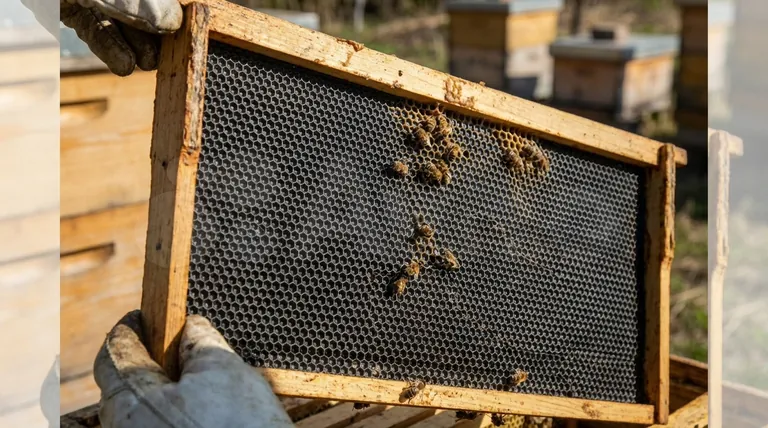At the core of every modern beehive is a choice between the two primary types of foundation: plastic and beeswax. Both serve the same fundamental purpose—providing a hexagonal guide for bees to build straight, uniform honeycomb. However, they are made from different materials, which has significant implications for durability, ease of use, and how readily your bees will accept them.
The choice between plastic and wax foundation is not about which is "better," but which best aligns with your beekeeping goals. Plastic foundation prioritizes durability and efficiency, while beeswax foundation offers a more natural option that bees often prefer.

What is Hive Foundation?
A Blueprint for the Bees
Foundation is a thin sheet, made of either plastic or pressed beeswax, that has the hexagonal pattern of a honeycomb cell base imprinted on its surface. It acts as a guide, or blueprint, encouraging bees to build their comb in a structured and predictable way within a removable frame.
The Problem It Solves
Without foundation, bees build "wild comb" that follows their own instincts. This natural comb is often curved and interconnected, making it impossible to remove individual frames for inspection or honey harvesting without destroying the comb and potentially harming the colony. Foundation is the key to modern, manageable beekeeping.
A Deep Dive into Plastic Foundation
The Case for Durability
Plastic foundation is extremely tough and rigid. It will not sag in high heat and is highly resistant to breakage during honey extraction in a centrifuge. This durability makes it a long-lasting investment.
Efficiency in Management
Because it is so robust, plastic foundation is ideal for large-scale beekeepers or anyone who values efficiency. It's easy to clean, reuse, and is less prone to damage from pests like wax moths. Most plastic foundation comes pre-installed in frames, saving significant time.
The Importance of a Wax Coating
A crucial detail is that nearly all plastic foundation is coated with a thin layer of beeswax. Bees are often reluctant to build on bare plastic. This wax coating encourages them to accept the foundation and begin drawing it out into comb.
Exploring Traditional Beeswax Foundation
The Natural Choice
Beeswax foundation is made from the very material that bees naturally produce to build their homes. For this reason, bees typically accept and start working on wax foundation very quickly, sometimes more readily than plastic.
Flexibility and Repair
Because it's a softer, more natural material, bees can easily rework and repair wax foundation. It gives the beekeeper more flexibility, as the bees can modify cell sizes for different needs, such as building larger drone cells.
The Challenge of Fragility
The primary drawback of beeswax is its fragility. It is more susceptible to damage during hive inspections and can be completely destroyed by wax moth infestations if not protected. It also requires more careful installation, often needing to be supported by wires embedded within the frame to prevent sagging.
Understanding the Trade-offs
Ease of Use vs. Installation
Plastic foundation is the clear winner for ease of use, as it often comes ready to go inside a frame. Wax foundation requires a more hands-on installation process, typically involving embedding support wires and carefully fitting it into a frame.
Pest Resistance
Plastic is inorganic and offers no food for wax moths, making it highly resistant. Beeswax foundation is a primary target for these pests and must be protected during storage.
Cost and Longevity
Beeswax foundation sheets are generally cheaper to purchase upfront than frames with pre-installed plastic foundation. However, the superior durability and reusability of plastic often make it a more economical choice over the long term.
Making the Right Choice for Your Apiary
Your ideal foundation type depends on your beekeeping philosophy, the scale of your operation, and how much time you want to invest in equipment management.
- If your primary focus is efficiency and scalability: Choose plastic foundation for its unmatched durability, reusability, and resistance to damage.
- If your primary focus is a natural, hobbyist approach: Choose beeswax foundation, as it's made from a natural material that bees readily accept.
- If your greatest concern is pest damage and longevity: Choose plastic foundation for its superior resistance to wax moths and its ability to last for many seasons.
- If you are most sensitive to initial setup costs: Choose beeswax foundation, as the individual sheets are typically less expensive to purchase upfront.
Understanding this fundamental choice empowers you to build a hive that works effectively for both you and your bees.
Summary Table:
| Feature | Plastic Foundation | Beeswax Foundation |
|---|---|---|
| Primary Material | Durable Plastic | Natural Beeswax |
| Bee Acceptance | Good (with wax coating) | Excellent (very natural) |
| Durability | High (resists breakage, pests) | Lower (susceptible to damage) |
| Ease of Use | High (often pre-installed) | Lower (requires wiring) |
| Best For | Commercial apiaries, efficiency | Hobbyists, natural approach |
Ready to equip your apiary with the right foundation?
At HONESTBEE, we supply high-quality beekeeping supplies and equipment to commercial apiaries and distributors through our wholesale-focused operations. Whether you need the long-lasting efficiency of plastic foundation or the natural appeal of beeswax, we have the right solutions to support your beekeeping success.
Contact our team today to discuss your foundation needs and discover how our wholesale options can benefit your operation.
Visual Guide

Related Products
- Food Grade Plastic bee Foundation for Bee Frames
- Notebook Style Beeswax Foundation Mould Wax Foundation Mold
- Electric Flatting and Embossing Machine with Tray for Beekeeping
- Electric Beeswax Foundation Machine With Operating Tray and Wax Foundation Roller
- Economy Manual Beeswax Embossing Mill Wax Foundation Machine Roller
People Also Ask
- How does plastic foundation differ from beeswax foundation? Choose the Best for Your Hive's Success
- How to get bees to use plastic foundation? Master the Wax Coating and Resource Strategy
- What is a plastic foundation sheet? A Durable, Reusable Hive Management Solution
- Why do commercial beekeepers prefer plastic foundation? Durable, Reusable, and Cost-Effective
- How to get bees to draw out plastic foundation? Boost Comb Building with Proven Tactics


















